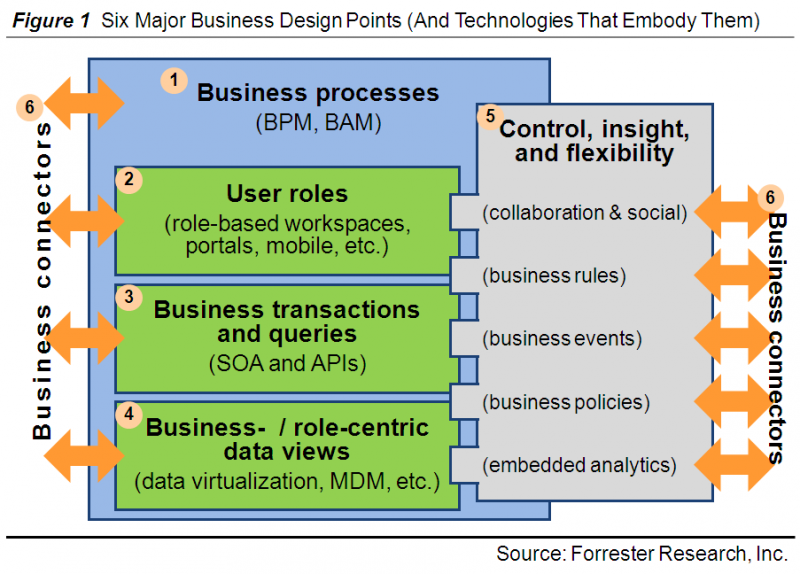Are You Doing Techie Integration Or *Business* Integration?
“Figuring out how to think about the problem.” That’s what Albert Einstein said when asked what single event was most helpful in developing the Theory of Relativity. Application integration is a problem. A big problem. Not to mention data, B2B, and other domains of integration. As an industry analyst and solution architect, what I’m most interested in first is how to think about the problem.
Pop Quiz: The Goal of Integration
Which of the following statements best articulates the goal of integration strategy?
- The goal of integration is to keep data in sync across two or more siloed applications.
- The goal of integration is to improve business outcomes by achieving consistent, coherent, effective business operations.
The correct answer is B. Was that too easy? Apparently not, because most of the integration strategies I see are framed as if the answer were A. Most, but not all — and it’s the ones framed around B that I’m most interested in. Here’s the difference:
- A-style integration centers on technology. It begins with data and business logic fractured across application silos, and then asks, “How can integration technologies make it easier to live with this siloed mess?”
- B-style integration centers on business design. It begins with a businessperson’s view of well-oiled business operations: streamlined processes, consistent transactions, unified tools for each user role, purpose-built views of data, and the like. It designs these first — that is, it centers on business design — and then asks, “How can integration technologies give us coherent business operations despite our application silos?”
If you’re pursuing B-style integration and have some real-world experience you’d be willing to share, I’d like to chat. Please email me: rheffner@forrester.com.
Real-World Examples Of Business-Centered Integration
Business-centered integration — or “digital business design” as I like to call it — aims to deliver measured improvement in specific business outcomes that a businessperson directly cares about. Its central model centers on six business design points, each of which a businessperson also cares about — or should (see Figure 1). As an integration strategy, digital business design aims to establish the decision models, design guidance, skills, delivery processes, agile governance, and infrastructure for a continuous cycle of business improvement. There are real-world examples of digital business design:
- Telco delivers major new process without adding yet another application silo. To support a new reverse logistics process (i.e., returns and repairs), a business VP was all set for final approval to purchase and customize a major new off-the-shelf application. The firm’s chief architect pleaded with the VP for three days to build, from scratch, a prototype based on business-centered integration. The business process design point was implemented using the Savvion BPM product (now owned by Aurea Software);
 the business transaction design point was implemented using SOA business services into existing applications. The prototype convinced the business VP to drop the packaged application plans, and within six months, a nationwide rollout was complete. The firm calculates that it achieved full return on its investment in less than three months.
the business transaction design point was implemented using SOA business services into existing applications. The prototype convinced the business VP to drop the packaged application plans, and within six months, a nationwide rollout was complete. The firm calculates that it achieved full return on its investment in less than three months. - Media firm gives radio station managers *the* tool for their job. For onboarding new employees, this firm’s radio station managers had to login to PeopleSoft, remember which screens to go to and what data to enter. They needed to remember what order to do things in, and they all had to relearn it all whenever the process changed. To give station managers back needed time to run the station, to reduce process errors, and to quickly bring new managers up to speed, the firm tossed out the user interface (UI) of PeopleSoft and designed around the radio station manager role, giving them the tool for their specific job: a custom UI focused on their work, with built-in process controls. PeopleSoft is still there, under the covers, with its business transactions now cleanly wrapped with SOA business services.
- Transportation firm establishes a business-centered application architecture. As part of a multiyear, enterprise architecture-driven renewal of its technology estate, this firm built its layered application architecture for the future on business concepts. At the lowest layer, canonical business data views provide a single point of truth for information (but not a single point of persistence). Above that, SOA provides a solid base of business transactions and queries. At the UI layer, rather than flipping between multiple application logins, customer service associates and other roles get customized UIs, streamlined for their particular jobs, insulating them from siloed application UIs. Business processes are embodied in and controlled by BPM, supplemented by business rules (in a rules engine) that embody key business decisions and policies.
Reading about these cases, you may say, “These technologies have been around for a while. What’s different?” Actually, the question reveals the difference. These firms don’t focus on the technology the way the question does — and more to the point, the way that integration strategy tends to do. Instead, they first understand key business metrics, design the business to optimize the metrics, and then ask what technologies might help to deliver the business design.
If you’re curious for more, two key reports outline Forrester’s future vision:
- "The Future Of Solution Architecture: Six Business Design Focal Points”
- "Digital Business Design Is The New Integration”
Are You A Business-Centered Integration Leader? Can We Talk?
I’m on a bit of a mission to help folks understand the importance of business-centered integration, its challenges, and how to make it real. So, as I said above, if you’re doing it — or seriously planning for it — please let me know. I’d very much like to chat.
Randy Heffner
rheffner@forrester.com